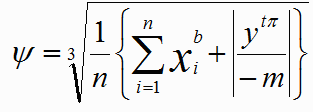Here we are at the start of a new year. For many of us, this is the time to plan and budget for the coming months.
One thing is obvious; Microsoft will give us plenty of choices. For example: Which Visual Studio Product is Right For You? Well, it’s a tough choice. My co-workers know me as a Brian, but there is the occasional Saturday night when I want to be a Charlotte.
You also have to factor in your options if you are a Microsoft Partner, and later this year we may choose between 20 Windows Vista SKUs.
The problem is, we don’t like choices. We like answers better. Solid answers based on quantitative analysis. Because of this, I spent the holidays doing some mathematical modeling and trying to devise a formula to make technology purchasing decisions. Here is what I came up with:

Now, for the simple definitions:
n is the number of developers you work with.
x is a value to assign to each developer. Assign a value of 2 if the developer primarily works in C#. Assign a value of 1 if the developer primarily works in VB.NET. Assign an arbitrary imaginary number if the developer primarily works in J#.
b is the amount of time (in seconds) it will take a photon to traverse all of your developers laying head to toe.
y is the number vertices on the organizational chart between you and the CEO.
t is amount of time it would take for you to fly to Seattle, Washington, assuming a snowstorm in Chicago, fog in London, and no flight delays in Cairo.
m is the mass, in kilograms, of all your source code printed on 10.5 lb smooth finished 8.5’’ x 11’’ paper.
The only problem is, I’ve yet to interpret the number the formula spits out. I’m hoping some bright people on the web might see this, and help out, because then we'd all know exactly what to do...

 OdeToCode by K. Scott Allen
OdeToCode by K. Scott Allen